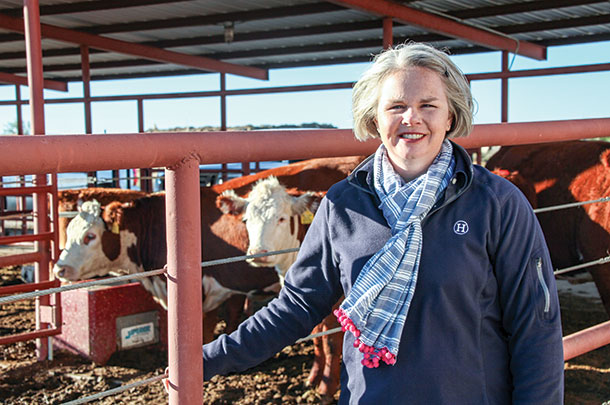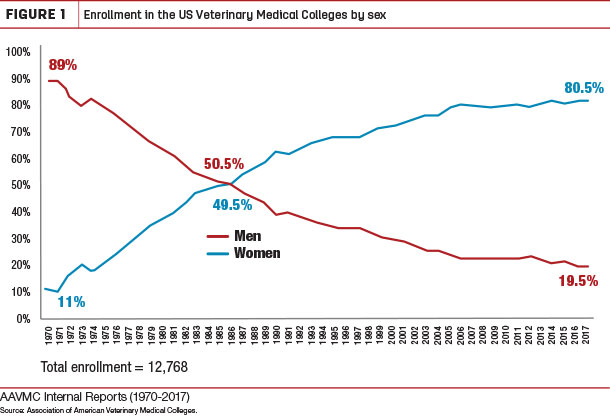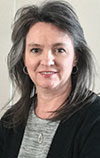The number of females attending colleges of veterinary medicine surpassed the number of male enrollees in 1986. And with current nationwide enrollment hovering around 80 percent women, most vets who retire in the coming years will be replaced by a female practitioner.
If your current vet isn’t a woman, odds are the next one will be.
Theories abound for the reasons behind this change.
In 1960, 98 percent of veterinarians were male, but the Title 9 legislation of the early 1970s made it illegal for graduate programs to discriminate admission based on gender. And the number of female applicants to veterinary schools has been steadily growing ever since.
In 1986, females surpassed 50 percent of enrollment in vet schools and, by 2009, the number of practicing female vets exceeded males. Many researchers argue no other profession in America has experienced such significant feminization.
As the gender shift of the profession gathers momentum, and the number of males continues to decline, it becomes more difficult to reverse the trend. Many vet schools today have special programs in place to specifically recruit male students.
Dr. Jessica A.A. McArt is an assistant professor of ambulatory and production medicine at Cornell University’s College of Veterinary Medicine. Cornell’s class of 2010 was 84 percent female, and the 2020 class will be 77 percent women. McArt and her colleagues actively mentor and encourage vet med students to pursue large-animal practice, specifically dairy.
“Our strong track record in graduating great dairy veterinarians attracts students interested in dairy production medicine,” she explains. “Mentorship in school as well as out in private practice has built a strong network of female dairy veterinarians accessible to our students in New York state and beyond.”

Dr. Angela M. Daniels of Dalhart, Texas, is the owner of Circle H Headquarters LLC, a veterinary practice, research and laboratory business. She has practiced for 18 years and was exclusive to dairy practice for 15 years. Daniels has made mentoring a priority.
“Over a 10-year span, we mentored nearly 80 veterinary and dairy science students,” she explains. “This was important because it was a chance to give back to the profession. It also enabled us to meet potential new hires when we had positions available.”
Daniels also hosts Food Animal Veterinary tours of first- and second-year vet students from Oklahoma State University and Texas A&M University. “Those groups went from being about 50-50 male/female to nearly 100 percent female.”
Daniels has witnessed veterinary salaries decline, fewer students with rural backgrounds, growing emphasis on STEM programs in school for girls and rising vet school tuition costs over the past two decades. All these factors influence the feminization of her profession.
“I have seen a lot of positive changes in the past 20 years, such as the Women’s Summit at the Western Veterinary Conference, the Women’s Veterinary Leadership Development Initiative and the Dairy Girl Network,” Daniels says.
McArt agrees. “In the last five years, it has been exciting to see women become more prevalent in organized bovine veterinary leadership positions,” she says. “This added publicity further encourages and empowers female students as they choose their future careers.”
Dairy producers witnessed the changing demographic firsthand. “My clients changed along with me,” Daniels says. “Today, my clients don’t really take note of gender. It’s a non-issue. They just want you to be hardworking, knowledgeable and care about their operation.”

“In my experience, most dairy producers have excellent relationships with their female veterinarians and likely have not given the gender of their veterinarian a second thought,” McArt says. Her favorite story on the subject comes from a previous (notably vertically challenged) female student who went on an emergency dystocia call during her first month of veterinary practice.
Upon arrival, the producer stared at her when she walked into the milkhouse and said, “Wow, you’re short.” The veterinarian replied, “Yeah? Well, you’re fat. Where’s the cow?” McArt says the two have gotten along famously ever since.
“There are a million different ways to do the jobs we need to do on a daily basis – and just because we may do them differently doesn’t mean we can’t get them done,” she says.
“I always expected to be treated like one of the guys when I’m on the farm,” Daniels says. “I would tell producers who may have their first female vet not to allow gender to be an issue. Treat them with respect and don’t cut them any slack.”
For women considering careers in the dairy industry, Daniels advises them to gain confidence by getting farm experience. “The dairy industry is a very rewarding place to spend a career. If you don’t come from a dairy farm background, work on a dairy. You will be a more valuable adviser if you understand your client’s perspective.”
Daniels was raised on a rural Iowa farm where they finished beef cattle and hogs. She cites Kit Spangler as a dairy farmer and key mentor. “He gave me a start in the dairy industry and answered all of my stupid questions,” she says. “Kit let me learn dairy from the ground up, which gave me a lot of confidence.”
That confidence translates into a respected professional reputation that stretches beyond the panhandle of Texas. “Choose a career you love, and you will never work a day in your life,” Daniels says.
“My main advice to dairy farmers about developing a strong professional relationship with their female veterinarian is no different than my advice for getting a new veterinarian, male or female,” McArt says. “Take the time to get to know them and understand they will do things differently than your previous vet. Change is how we make progress.” ![]()
PHOTO 1: Jessica McArt says female veterinarians may need to do certain jobs a different way, but they can certainly still handle the tasks. Photo provided by Jason Koski, Cornell University Marketing Group.
PHOTO 2: Although dairy is the vast majority of Dr. Angela Daniels’ practice, she and her husband raise Hereford cattle. Photo provided by Angela Daniels.
Karena Elliott is an international freelance writer. She makes her home in Amarillo, Texas.







